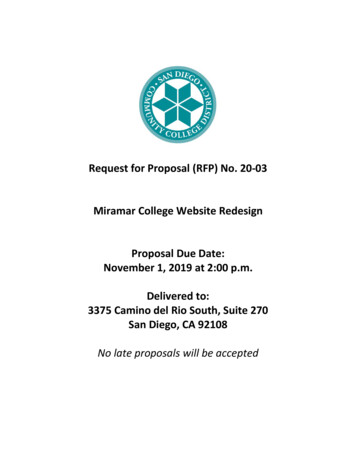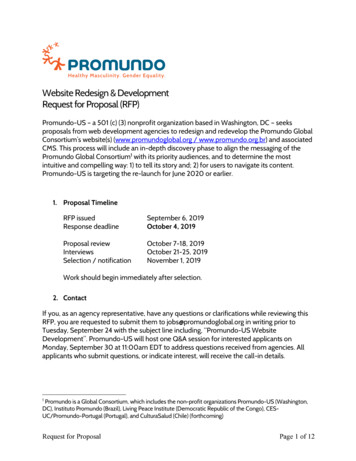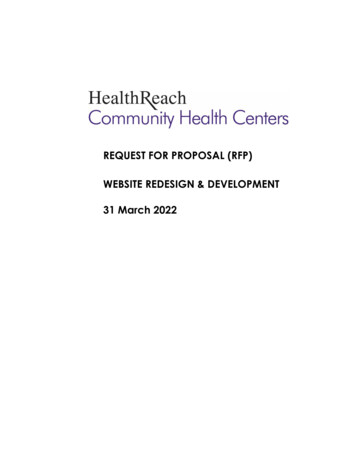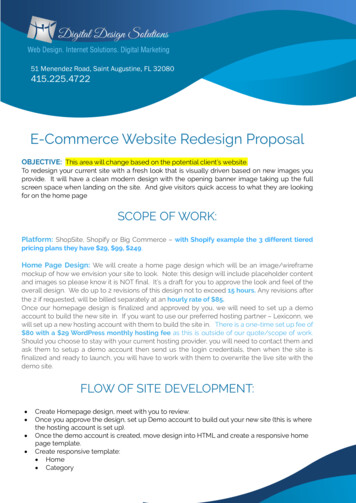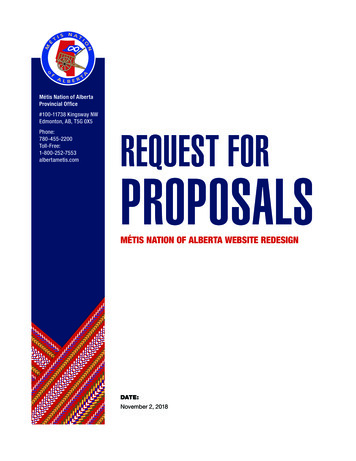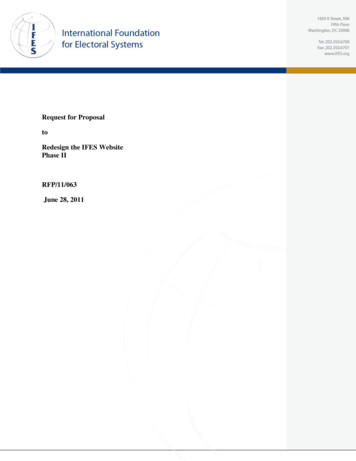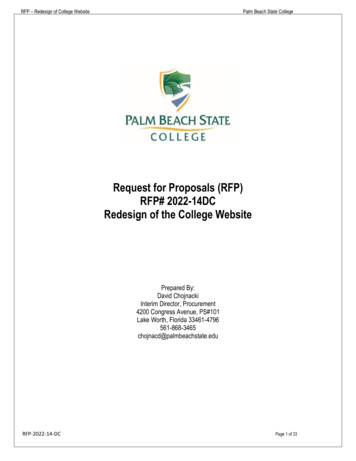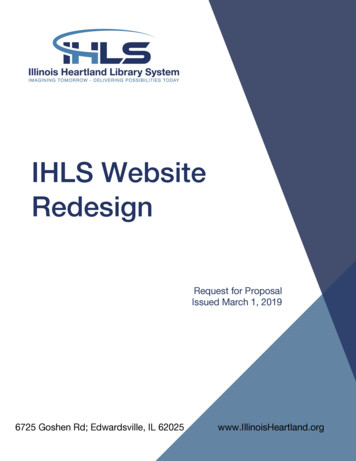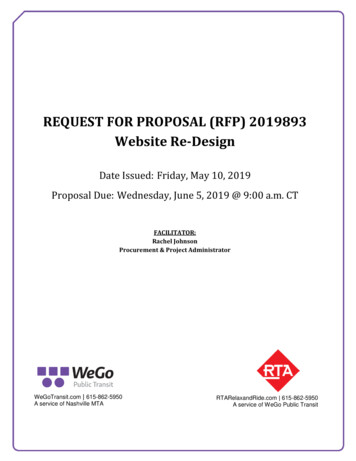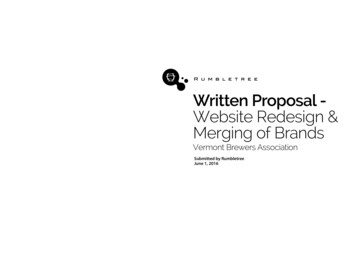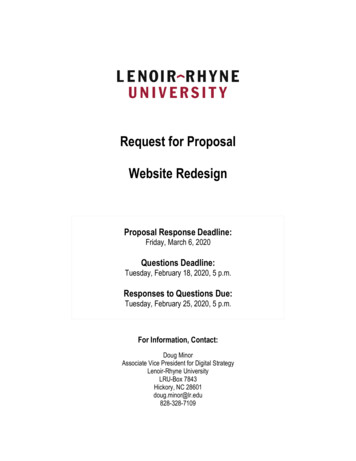
Transcription
Request for ProposalWebsite RedesignProposal Response Deadline:Friday, March 6, 2020Questions Deadline:Tuesday, February 18, 2020, 5 p.m.Responses to Questions Due:Tuesday, February 25, 2020, 5 p.m.For Information, Contact:Doug MinorAssociate Vice President for Digital StrategyLenoir-Rhyne UniversityLRU-Box 7843Hickory, NC 28601doug.minor@lr.edu828-328-7109
Table of Contents1.RFP PURPOSE . 32.PROJECT GOALS . 33.REQUIREMENTS . 34.PROJECT DELIVERABLES . 55.BACKGROUND – STATE OF CURRENT WEBSITE . 76.ABOUT LENOIR-RHYNE UNIVERSITY . 137.INSTRUCTIONS TO VENDORS. 138.PROJECT TIMELINE . 149.PROJECT BUDGET . 1510. PROPOSAL SUBMISSION DEADLINE . 1511. CONTACT INFORMATION. 15APPENDIX A: REBRANDING – HOW WE TALK ABOUT LENOIR-RHYNE UNIVERSITY . 16APPENDIX B: PEER INSTITUTIONS / COMPETITORS FOR APPLICANTS . 17APPENDIX C: INTRANET REDESIGN PROJECT . 18APPENDIX D: TYPICAL CONTRACT TERMS . 19Lenoir-Rhyne University Web Redesign - Request for Proposal (Confidential) - 2
1. RFP PURPOSELenoir-Rhyne University seeks proposals for a comprehensive website redesign from interactive design agencieswho have experience with higher education. The university is also interested in leveraging its public website redesignproject, site development, and code base for a separate intranet site developed on the same CMS platform as thepublic website. More details about the intranet project can be found in Appendix C.Lenoir-Rhyne seeks a partner driven by innovation, audacious in its thinking, and excited by the opportunity to createsomething entirely new. The agency selected to design and build the next iteration of lr.edu will be passionate aboutthe liberal arts and embrace its vital importance to our global, interconnected society.We seek a strategic partner and creative and technical team that will quickly grasp Lenoir-Rhyne University’s brand,our values, our culture, and the university’s strategic direction as noted in the About Lenoir-Rhyne and Appendix Asections. The university seeks a partner who can help us leverage our website to demonstrate the value of the liberalarts. This project will deliver a new digital strategy and web presence that elevates the university and reflects bestpractices in design, content strategy, user experience, usability, accessibility, and technical implementation.2. PROJECT GOALSThe Lenoir-Rhyne website is a key element in the university’s marketing and communications efforts and is animportant vehicle for delivering information to external and internal audiences and key stakeholders. It’s a vitalrecruitment, fundraising, and storytelling platform for Lenoir-Rhyne.The goals of the redesign project include: A site that showcases Lenoir-Rhyne’s brand strengths, qualities, and values.A site that targets prospective and current undergraduate and graduate students and their families withoutsacrificing the needs of secondary audiences, including current students, alumni, current and prospectivefaculty and staff members, the media, and general public.An information architecture that organizes content in an efficient and logical manner for primary targetaudiences, while preserving deeper content structures to meet secondary audience needs.A site with a more modular, flexible visual design that is fully functional and responsive in design for displayacross many screen sizes and devices.A technology platform that is robust and mobile-first in focus, yet flexible enough to continue to grow andevolve with our web presence. Ideally, we hope to easily reskin the site over several years while retaining anunderlying platform and architecture allowing for long-term evolution.Assistance with the development of a content strategy, personas, and content framework for the site.Evaluation of our current website governance and site management, site support, hosting, andrecommendations to support our new website strategy.3. REQUIREMENTSThe redesigned website will do the following. Focus on user experience.Follow web standards (HTML5, CSS3).Lenoir-Rhyne University Web Redesign - Request for Proposal (Confidential) - 3
Strictly adhere to web accessibility standards— WCAG 2.1 & WCAG 2.0 Level A & Level AA, Section 504,Section 508 (2017).Display optimally on a range of screen sizes and devices (smartphones, tablets, desktop monitors). Amobile navigation for smaller screens and a desktop navigation for larger screens.Be optimized (design, architecture, and hosting platform) for fast loading—particularly on mobile devices asmeasured by Google PageSpeed Insights (fast performance of 90 or better). Utilize approaches like a CDN,caching, minifying CSS and JavaScript, and “lazy loading” of page elements for optimized page load times.Our research suggests page load speed is crucial to perceived and actual site success and improvedsearch engine optimization (SEO).Render properly in widely used mobile and desktop browsers (Chrome, Edge, Firefox, IE, and Safari)Incorporate SEO best practices to improve site visibility. This includes the ability to manually change metainformation/tags on each individual webpage—Page Title, Meta Title, Meta Description, Meta Image, PageCrawl Frequency, ability to hide pages from public/internal search and sitemap (no index, no follow), clearpage name/URL structure (pages URLs all lowercase using hyphen separators), and an automated XMLSitemap. Pages should be properly structured to use H1-H5 headers. Provide ability to include a robots.txtfile for limiting search engines to some content.All website content must be directly displayed as webpages and indexable by search engines, i.e., websitecontent that opens in an overlay that is not directly accessible to website visitors through a URL or searchengines should be avoided. Important pages that must be indexable by search engines include homepage,landing pages, secondary pages, campus calendar landing page, individual event pages, campus directorylanding page, individual faculty directory/biography pages, majors and programs, courselistings/descriptions, etc.Offer content syndication and content sharing—COPE (create once and publish everywhere). Content thatis duplicated in multiple places should be updatable and maintained in single location. For example, offeringthe same academic program content for a hidden digital advertising landing page as we do for the mainacademic program page—the content is updated in one place and published out to both pages. We shouldbe able to do this at the page and section/component/widget level, while also having the ability to displaysome different elements on similar pages, e.g., the hidden landing page might have an RFI form, the publicpage might not.Provide a modular or atomic design framework allowing for more flexibility in content design and deliveryacross site pages. Here is an example of modular design from Indiana University. In such design, the samecontent component (e.g., student testimonial, brand messages, news stories, content featurettes, videos,lists, events, etc.) can be published in multiple layouts on a page—across one column, two columns, fourcolumns, or six columns. We change our focus in page design from whole pages into parts, making itpossible for our website to combine content and design, but also allowing our CMS more control. This willallow us to build out pages in ways that make sense from a visual, administrative, and business perspective.A modular or atomic approach to design and populating content will offer us a more flexible and adaptablesite that is nimble enough to address changing institutional and visitor needs.Provide a pattern library that offers multiple options for content display, e.g., a blockquote might come withbig bold text with a large background quotation, another might include an image, yet another with a verticalline. The pattern library would offer multiple button, list, image, video, accordion or tab styles, among others.Integrate social media content/feeds from university accounts within the website whenever possible forTwitter, Facebook, and Instagram.Provide the ability for website personalization either using a built-in or add-on personalizationmodule/engine or utilizing a site-wide taxonomy. We are open to doing a phased approach and pushingpersonalization off to Phase 2 as long as Phase 1 site development doesn’t prevent later sitepersonalization work. We are particularly interested in the idea of prospective students being able to createLenoir-Rhyne University Web Redesign - Request for Proposal (Confidential) - 4
a “Custom Viewbook” from our website, similar to a product offered by Custom Viewbook customviewbook.comBe optimized to share webpage content to social media sites like Facebook, Twitter, and LinkedIn byemploying separate Open Graph (OG) protocol and Twitter cards on every page to specify page title,descriptions, image, and video. It is preferred that all of these tags populate from the main meta fields, butallow us the ability for them to be individually edited.Ability to easily add code to the head , beginning of body and end of /body at the site level and at theindividual page level. We often need to add or update tracking/retargeting/conversion pixels to our site andsite administrators should be able to do this easily without requiring development support.Include responsive, accessible, semantic data tables. Tables should automatically stack their layouts formobile screen sizes. Various design options will be available to stripe alternate rows with darker color toincrease contrast.Ability to manage all 302 and 301 URL redirects through a single website redirect module or apache.htaccess file. This includes the ability to redirect documents to webpages or other documents.Website multilingual support should be available via an add-on module.Run all website pages and associated scripts, CSS, and assets under an SSL certificate (https://) forimproved SEO and site security. All webpages should be run through a non-secure content scan likehttps://www.jitbit.com/sslcheck before launch. Have the ability to redirect automatically all http:// traffic tohttps://Use non-proprietary programming and frameworks for interactive features.Follow best practices for website development, which includes a code repository, dev or staging websiteand a production website.4. PROJECT DELIVERABLESThe vendor must produce the following project deliverables.Discovery, Strategy, User Experience, and Information Architecture Project discovery and research.o Deep dive into Google Analytics for current website to inform redesign project.o Review of provided brand documents.o 2-3 days of onsite project discovery or client workshops, including invited stakeholder groupsessions as well as open sessions for the campus community.o Web survey(s) for primary and secondary audiences. Web strategy brief, including development of website personas. Creative brief. Proposed information architecture, user experience, and content strategy. Review of current website governance, site management and staffing, and provide a brief withrecommendations for any changes for current website management and support. A content management system and hosting recommendations brief. Lenoir-Rhyne seeks the guidance andadvice from vendor in the selection of a new CMS and hosting platform that best supports the university’sdigital strategy. Our preference is to use an open source platform like Drupal, but we are open to aproprietary CMS that is widely used in higher education and supported by a large number of vendors oragencies. We are familiar with a number of popular CMS platforms such as Drupal, WordPress, Hannon HillCascade Server and are open to considering these and other systems. We are not considering OmniUpdateLenoir-Rhyne University Web Redesign - Request for Proposal (Confidential) - 5
OU Campus (they don’t offer a vendor implementation partnership program), TerminalFour (cost), or ourcurrent Finalsite CMS (clients are primarily K-12 schools). It is unknown at this time how many CMSlicenses are needed if we were to select a proprietary CMS over an open source CMS. We anticipate fewerthan 20 licenses, but our preference is to select a CMS that offers an unlimited or high number of licenses.Vendor shall address how a code repository, development or staging site, and production website workflowwill be used for maintaining and tracking changes to the website’s code base, e.g., GitHub, GitHub Labs,etc.Post-website launch support, maintenance, and ongoing site development proposal. This should includerecommendations and a menu of options and pricing for ongoing website support, maintenance, andongoing development options or packages, e.g., bulk purchase of hours (pre-paid), pay as you go or perhour pricing (time and materials). Vendor should detail any warranty of code or bug fixes that are identifiedpost-launch.Design/Build Lenoir-Rhyne will likely rewrite all website content in-house. Vendor will propose a process forautomating/easing content migration, e.g., scripts to export content from current Finalsite CMS to new CMSand/or service/system for tracking written website content that allows for review and approval and migrationinto the new CMS, e.g., products like GatherContent, Smartsheet, etc. Process should support written text,photography, video and SEO (page titles, meta descriptions, etc.). Design renderings for page layouts (specific decisions to be determined in site strategy) – homepage,audience gateways, campus location homepage landing (may duplicate main homepage with ability tomodify as needed for each campus location), department landing, lower level, news landing, news storypage, news index, search index/results, academic majors/programs listing page, academic program landingpage, academic course listing page, campus directory, faculty and staff bios page, campus calendar landingpage, campus calendar events page, social media integration. As noted in this document, the university isinterested in a flexible, modular or component design framework. We are also interested in the developmentof a robust pattern library for the site. Coded HTML, CSS, and JavaScript Native integration of APIs (e.g., social channels: YouTube, Twitter, Facebook, etc.). We primarily useYouTube for videos. We want to be able to control the thumbnail image that is used and remove YouTubebranding and YouTube video information (video title). Graphic elements required by the design. Technical implementation of selected CMS and integration of design templates, modules, andcomponents/widgets. Details and assistance with the development of CMS editorial workflows, approval workflows, and sitepermissions. Static HTML and CSS files as well templates (headers and footers) used for reskinning third-party sitesand services. Site style guide – this should live on the LR website or is provided directly to LR. It would include apattern library, typography, various column layouts, and cover all design and style options. Site training documentation – this should live on the LR website or if done using a separate service orwebsite, direct ownership access provided to Lenoir-Rhyne University.Website HostingLenoir-Rhyne is interested in a cloud-hosted, managed hosting platform or service, e.g. Pantheon, Acquia,Lenoir-Rhyne University Web Redesign - Request for Proposal (Confidential) - 6
Rackspace, AWS, or other similar hosting solution. It is our expectation that the hosting platform providequalified web hosting support by phone, email, and online ticketing, offer 24/7 support availability, provideongoing, automated upgrades and security patches, and provide a 99.9% uptime guarantee. The selectedvendor for the redesign project will help specify and provide recommendations, including content deliverynetwork (CDN), technical set-up, storage, RAM, sFTP, etc., to Lenoir-Rhyne for website hosting that will supportthe new CMS and associated website applications. It is preferred that the vendor have direct experienceworking with the recommended hosting provider(s).Intranet SiteThe university is interested in leveraging its public website redesign project, site development, and code base for aseparate intranet site developed, maintained, and hosted on the same CMS and hosting platform as the publicwebsite. We see the intranet site offering a slightly different header and footer “skin” than the public website to clearlynote it as a separate, internally focused site, but offer the same site design and functionality as the public website.More details about the intranet project can be found in Appendix C.Offering an intranet site on the same CMS and hosting platform as our public website allows us to: (1) develop, train,support, and develop on single platform, (2) realize cost savings from implementing and supporting a single sitetechnology, and (3) leverage site development done for either the public website or intranet on the other site.5. BACKGROUND – STATE OF CURRENT WEBSITEBackgroundThe current Lenoir-Rhyne website (www.lr.edu) was launched in August 2016 with initial project work started in2015. In 2016, the university implemented centralized website management with website content changes andongoing website development done entirely by the Marketing and Communications Office.The university’s website uses Finalsite, a propriety CMS primarily used by K-12 schools. Only a handful of collegesuse Finalsite for their websites. Finalsite offers a multi-column page builder, however, only a handful of predesigned classes or modules/widgets were created so typically just text and images are used in multiple columnlayouts. The current website is built on a responsive design framework.The current website design is now dated and it lacks an engaging design that extends beyond just a few top-levellanding pages— the current homepage, undergraduate and graduate admission pages, academic page, student lifepage and Profile Magazine section.Brand Voice/MessagingIn assessing our current website, it is clear that it lacks a clear, cohesive brand voice and messaging that setsLenoir-Rhyne apart from competitors. Site design and typography is poor, site photography is often repeated, iscliché or posed, and there is limited use of video across the site. The current website misses the mark incommunicating Lenoir-Rhyne’s close-knit and supportive community, the totality of the student experience, andstudent and alumni outcomes. Since these are major selling points for the university, this will be a major focus of ourwebsite content strategy to emphasize across the website, including on academic program pages.In 2019, Lenoir-Rhyne undertook a rebranding and messaging effort with Carnegie Dartlet. This work produced aLenoir-Rhyne University Web Redesign - Request for Proposal (Confidential) - 7
new brand voice for Lenoir-Rhyne that is not yet reflected on the university website. The website redesign projectwill be an important project for rolling out the new brand voice for the institution in a visible way. Visit Appendix A formore information about Lenoir-Rhyne’s rebrand project and how we talk about the university.User ExperienceOverall the site offers a poor user experience for website visitors because of inconsistent navigation (e.g., centerednavigation, left-column navigation or use of buttons for navigation), inconsistent header styles, a large amount ofwebsite content is hidden in accordions and there is poor content prioritization and editorial decision-making.Multiple CampusesLenoir-Rhyne’s main campus is in Hickory, North Carolina. The university also offers graduate degree programs onits campuses in Asheville, North Carolina, and Columbia, South Carolina. The Lutheran Theological SouthernSeminary (LTSS) is also in Columbia. The current website lists these campuses as lumbia and https://www.lr.edu/ltss.The new website needs to better meet the target audience needs for Asheville, Columbia, and LTSS. Currently,these campus webpages are hard to find and visitors interested in information or programs on these campuses areoften pushed back to content on the main campus website that may not be relevant or is potentially confusing.Target audiences, event faculty and staff, often have an affinity for their specific campus location that is notnecessarily shared with the university’s main campus in Hickory. We need to keep this in mind as we develop theuser experience, IA, and content for these campus landing pages. We are not envisioning any special functionalityor technical requirements for these campus sites, rather, repurposing design elements and functionality from themain site and spending more time on developing an improved user experience, information architecture, andcontent strategy for the campus sites.Academic Programs ListingThe academic program grid list is confusing and has some usability issues. The programs grid moves from left toright on desktop and mobile. This is not clearly apparent on mobile devices. On desktop and mobile, visitors canbecome easily lost if they select the wrong choices in the many dropdown menus.A more simplified horizontal list is preferred that doesn’t require a large amount of scrolling, doesn’t offer lengthypagination, offers fewer choices, but provides the ability to do a program keyword search populating results in thesearch field. Most visitors view programs by subject area or major/program, by undergraduate and graduate and bycampus location. Including the school or college in the program listing criteria unnecessarily complicates the listingof programs and should be discontinued in the new listing format.Academic Program PagesOur academic program pages will be a priority for the website redesign project given their importance to prospectiveand current students and their parents. Currently, our major/program webpages are overly text heavy and devoid ofimages and interactive content. There is no prioritization of content on pages, limited use of headers, and limitedfocus on the student experience—academic research and scholarship, faculty-student engagement/mentorship,study abroad, internships and careers, civic engagement, student organizations/activities, student and alumnioutcomes, student testimonials, faculty listings and faculty biography pages or course information.Lenoir-Rhyne University Web Redesign - Request for Proposal (Confidential) - 8
Using our current CMS and existing design capabilities, we have begun building out more engaging academicprogram pages specifically for marketing priority graduate programs or for digital advertising campaigns. You canview two examples at https://www.lr.edu/mba and https://www.lr.edu/counseling. An example of a new givingcampaign page can be found at https://www.lr.edu/give/giving-tuesday.Website AccessibilityThe current website is not in compliance with WCAG 2.0 Level A and Level AA. The university is currently usingAudioEye to offer a limited level of accessibility compliance. We plan to discontinue the use of AudioEye once thenew fully compliant website is launched.Site SearchThe Lenoir Rhyne website uses Algolia Search with Finalsite CMS and not Google Custom Site Search. We arelimited by the current search and are not able to elevate internal search results using promoted keywords, removepages from appearing in search results or use search synonyms and other features. We would like to use eitherGoogle Custom Site Search or another free or low-cost search option that offers us more functionality andintegration with Google Analytics and Google Search Console. We also need a sitemap created to share withexternal search engines for SEO.NewsNews headlines are currently displayed on the university homepage with a photo and headline. The website offers anews index template and news story template that automatically displays the news story image thumbnail on thenews story page. We have the ability to tag content to appear under specific areas of the website based on campusor department. We would like the ability to use taxonomy and share news stories throughout the site, including ondepartment/program landing pages, campus landing pages, etc. We also want to present more visually engagingnews stories that offer photo and video galleries, blockquotes and other designed components that are available tothe main website.University MagazineLenoir-Rhyne maintains a digital version of its university magazine at https://www.lr.edu/profile-magazine. This sitecould replicate functionality and design elements that are developed for the news index page, news landing pageand a news story page. In this area, like with news, we want to be able to use taxonomy for managing magazinecategories/topics and issue dates.Event CalendarThe current website offers an event calendar, but individual event pages are not available (all events open in anoverlay window). This is problematic for a few reasons: (1) calendar event URLs can’t be shared by email or socialmedia to promote individual events, (2) events can’t be indexed by search engines, (3) similar events can’t begrouped for display by taxonomy tag or event category to promote or find similar events, (4) there is no calendarsearch, and (5) you must instruct visitors by email, over the phone, or word of mouth how to go to the calendar andlook at a specific date and time to find an event.Our current calendar also does not allow for faculty, staff, and students to submit their own event informationLenoir-Rhyne University Web Redesign - Request for Proposal (Confidential) - 9
directly to the calendar and does not provide editorial workflows for event review and approval prior to publishing.All events are added to the calendar by marketing and communications staff.Campus events are important to building and engaging the university community and external constituents. Anyfuture calendar should feature: (1) individual event landing pages with their own unique URLs, (2) strong SEO andbe indexable by internal and external site search, (3) display similar events or event categories using taxonomy tagsor event categories, (4) offer event search, (5) offer online registration (paid or free RSVP/tickets), and (6) offer theability to share individual events by email or share events by date range, e.g., an automated weekly email digestthat is sent to subscribers.The future CMS should offer a strong events calendar module that meets the above needs and is integrated withinthe site. However, as part of the redesign project, we will also evaluate Localist calendar and the LiveWhalecalendar. Both of these products offer robust calendars features, with strong SEO and engagement tools. If either ofthese are selected, the calendar will need to be “skinned” to match the rest of the Lenoir-Rhyne website.Online FormsThe current website offers an integrated online form builder module. The form module is used to create a number ofdifferent online forms, including simple submission forms, RFI forms, online giving forms (for universityadvancement), job applications (university employment openings are posted online and applications are processedusing the online forms module). The current form offers the ability to accept online payment. The future websiteshould also offer online form capabilities, either through an add-on module or third-party application, andaccept/process online payments.We are anticipating that we will move the university advancement online giving forms to our CRM provider,Blackbaud NetCommunity (gifts are manually entered in Blackbaud now) and we hope to move to an external onlineemployment system or job board. Right now, all university jobs are posted by the marketing and communicationsstaff with access provided to various search committee members to review submitted job applications.Single Sign-On (SSO)The current website CMS does not use SSO authentication for website CMS administrators, editors, and contentauthors. The future CMS should authenticate users through Active Directory Federation Services (AFDS).Campus and Faculty DirectoryThe current campus directory is managed and updated directly through the CMS. It is not integrated with ouradministrative CRM, Ellucian Banner. New
Website Redesign . Proposal Response Deadline: Friday, March 6, 2020 : Questions Deadline: Tuesday, February 18, 2020, 5 p.m. . Lenoir-Rhyne University seeks proposals for a comprehensive website redesign from interactive design agencies who have experience with higher education. The university is also interested in leveraging its public .
